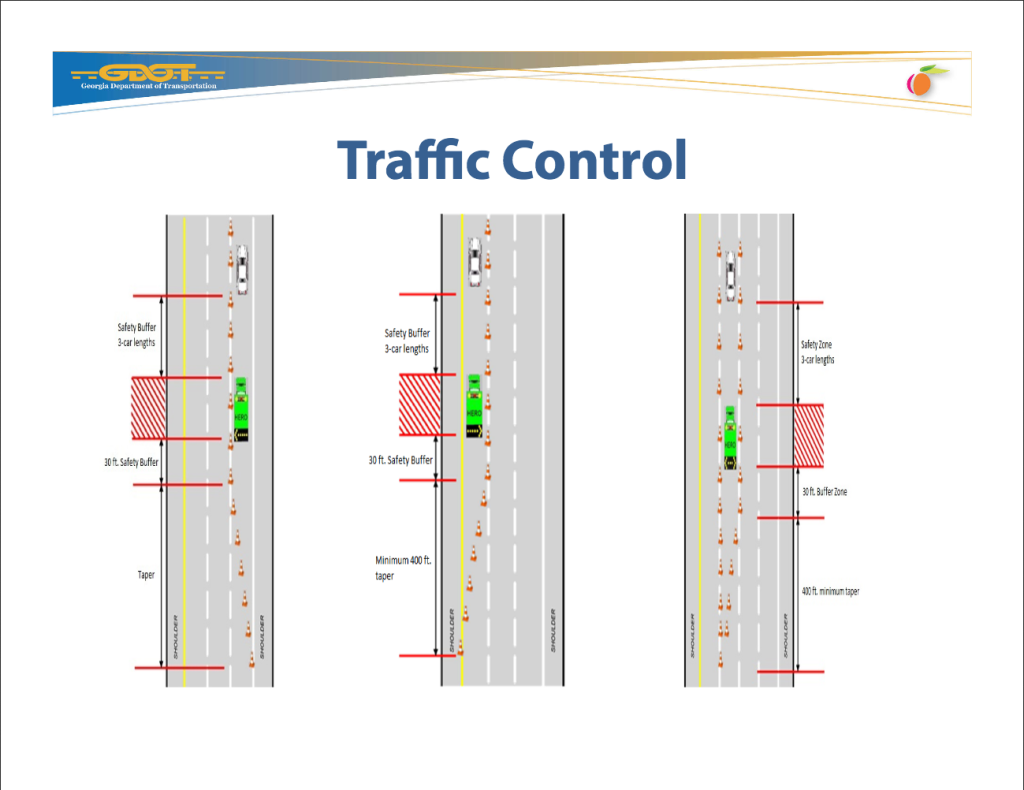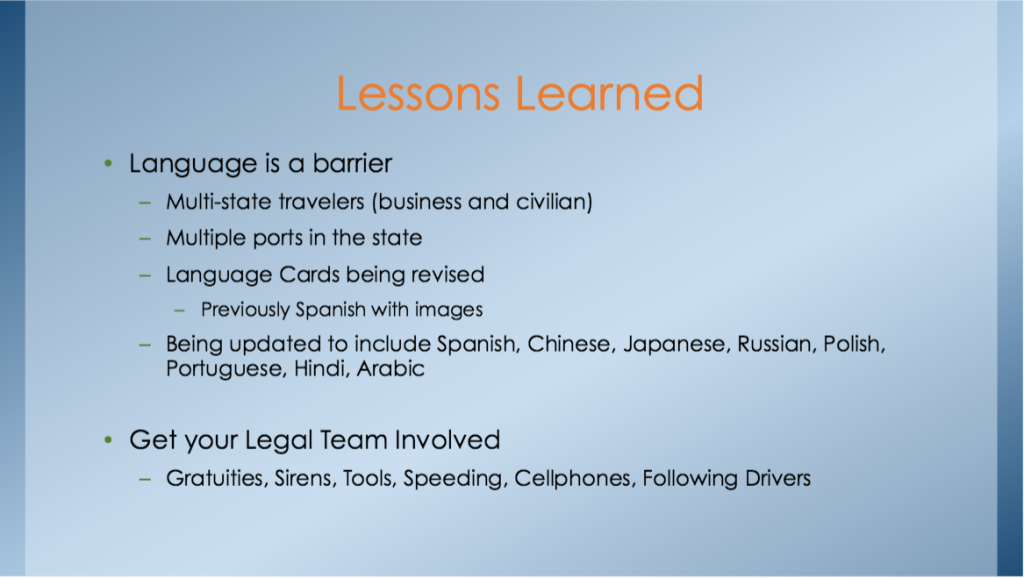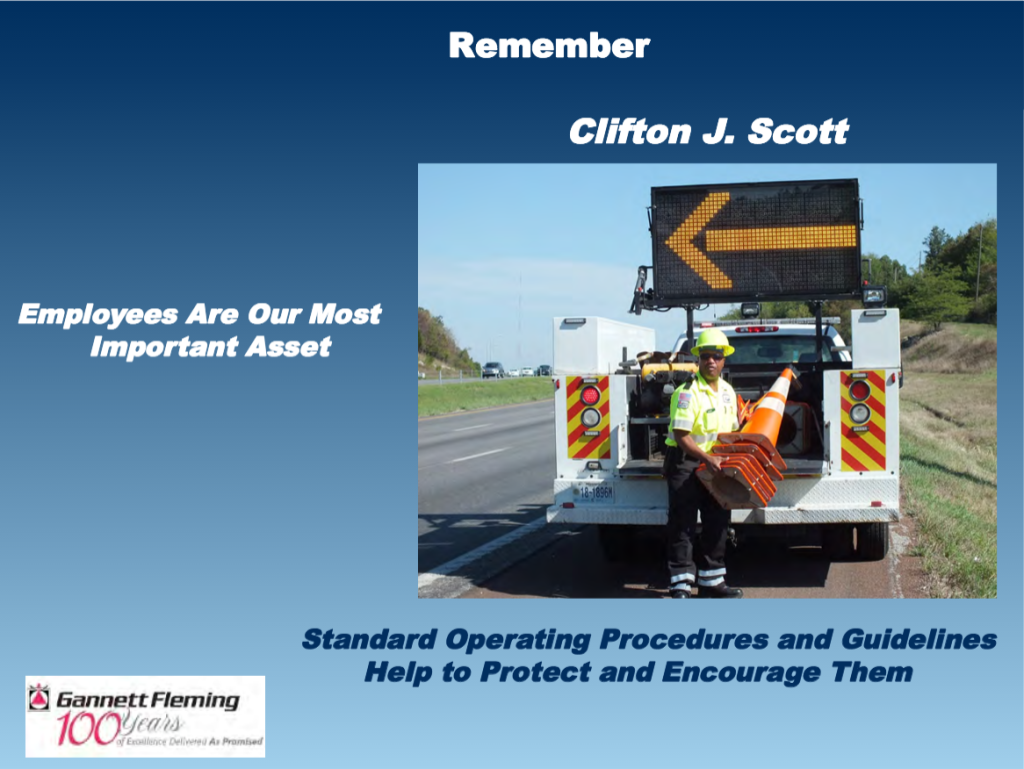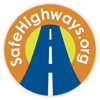FHWA and SafeHighways.org Team Up for SSPs
On June 26, 2015, the Federal Highway Administration (FHWA) and SafeHighways.org hosted the first-ever Safety Service Patrol (SSP) Idea-Sharing Network Session. The session marked the start of an effort to offer quarterly interactive forums for SSP program managers and FHWA division leaders. More than 50 professionals and representatives from federal and state government agencies as well as private sector companies attended.
The sessions were initially conceptualized by FHWA, led by Kimberly Vásconez, team leader of FHWA’s traffic incident and events management team, and announced in the October 2014 TIM Network newsletter. In the newsletter, Kimberly captured the objective of the new initiative:
“We recognize that Safety Service Patrols have not had a channel to express their opinions and provide formal input into the National TIM program, as do law enforcement, fire, towing, EMS, and transportation. As a result, Joey Sagal, another new member working on TIM and with the FHWA Resource Center, and former manager of the Maryland CHART program, will work with Grant Zammit, Manager of the Operations Technical Support Team of the Resource Center (and Joey’s supervisor) and me to set up a webinar to pull together Safety Service Patrol leaders from around the nation. We want to provide a platform so that they may communicate and share experiences and needs for national attention.”
Shortly thereafter, Kimberly contacted SafeHighways.org, a national online publication addressing topics pertinent to SSPs since 2010, to seek support of FHWA’s initiative. SafeHighways.org Program Manager Elizabeth LaBelle and Consultant, Sam McClain, welcomed the opportunity to participate and assist in leading the discussions. Over the next several months, FHWA and SafeHighways.org team members collaborated and planned for the first session.
The team decided to focus each session on a new topic and allow presenters and the audience to share best practices from their state’s patrol. After conducting a survey of SSP program managers and FHWA division leaders, FHWA and SafeHighways.org determined an order of topics to be discussed on each call, beginning with Standard Operating Procedures (SOP) for SSPs.
SOPs are established guidelines and routine methods for patrol operations defined by the federal government and by the state agency that operates the patrol. In December 2009, FHWA released it Field Operations Guide for Safety/Service Patrols, which outlines SOPs for SSPs across the country. It covers personal safety, roadway safety, temporary traffic control procedures as well as guidelines for responding to incident scenes. The FHWA states:
“It is expected that Safety/Service Patrol personnel will carry the guide in their vehicle to use as a quick reference while performing patrol tasks. They should refer to this guide on a regular basis as a refresher on steps and tasks associated with managing incidents – particularly for those situations not encountered every day. This guide is not designed to stand alone, but in conjunction with training and exercises that will indoctrinate the Safety/Service patrol operators into these good practices as well as Agency formal Standard Operating Guidelines or Procedures.”
As part of the guide, FHWA also provides checklists for procedural response to various incidents scenes and visor cards for easy reference and placement within the patrol vehicle.
The June 26th webinar on SOPs opened with a brief introduction from Mark Kehrli, director, FHWA office of transportation operations, who welcomed participants to the call and emphasized the importance of the new initiative to increase idea-sharing among SSP program managers. Kimberly Vásconez then spoke to the FHWA’s efforts to train first responders and to improve upon traffic incident management communications. Kimberly also shared this video focused on FHWA’s SHRP 2 TIM Training:
Joey Sagal served as the webinar’s moderator and introduced the three presenters each of whom addressed their experience with SSP SOPs and the best practices that their states have learned and implemented as standard operating procedure over the years.
Michael Roberson, former Georgia Department of Transportation (GDOT) incident management unit (H.E.R.O.) manager, provided a walk-through of the procedures the DOT’s H.E.R.O. unit follows from dispatch to incident response. He relayed that GDOT Traffic Management Center (TMC) uses four main sources of information to monitor and maintain traffic flow on the roadways: 1) Cameras/detectors; 2) Calls to 511; 3) Calls from 911 dispatchers; and 3) HERO operators on patrol.

As part of his presentation, Michael Roberson highlighted proper traffic control procedures to ensure the safety of patrol drivers and motorists.
Michael also shared GDOT best practices relative to traffic control set-up; the push, pull, drag methodology; and its Towing Recovery Incentive Program (TRIP). For GDOT, the HERO truck is the first traffic control device and the HERO driver must follow standard operating procedures to assess an incident scene and to set-up a safety parameter around the incident. For example, SOP regulates that the HERO vehicle be positioned three car lengths back from the incident or disabled vehicles and safety cones be positioned behind the HERO truck to provide an additional 30 foot safety buffer, plus a minimum 400 foot taper. The HERO vehicle is also equipped with the ability to push or pull vehicles to safer locations along the highway. Michael walked through the various push/pull procedures dependent on the weight and size of the vehicles. Lastly, Michael highlighted GDOT TRIP, which provides a monetary incentive to towers for clearing incidents in less than an hour.
Salvatore Cowan, New Jersey Department of Transportation (NJDOT) director of traffic operations, offered insight into the process by which the DOT updates its Standard Operating Procedures, including annual updates to content, which includes guidance and policy information on vehicles and equipment, uniforms, patrolling techniques, and field operations. Sal then identified the NJDOT’s five core elements of SSP SOPs:
- Clearly defined roles with direct impact on incident duration;
- Employee responsibility and shared resources;
- Patrolling techniques;
- Common situations and actions (for which SOP covers over 20 unique situations); and
- Flexibility in coverage of nonrecurring, special or emergency needs and events.

NJDOT’s Salvatore Cowan shared two lessons learned when crafting Standard Operating Procedures and reminded webinar participants to consider these lessons in their own states.
Lastly, Sal shared that NJDOT has learned two important lessons while defining its SSP SOPs: 1) Languages can be a barrier to SSPs on the road and language cards can help to overcome these barriers; and 2) Involvement from the DOT’s legal team can ensure issues such as employee conduct and gratuities are addressed in advance.
Rusy James, Gannett Fleming, Inc. incident and emergency management specialist, and former incident management coordinator for Kansas City Scout, closed out the presentations. Rusty emphasized the role SOPs play in protecting SSP operators, the patrols’ “most important assets”. He recognized Clifton J. Scott, a Kansas City Scout operator who was struck and killed in the line of duty in 2012. Rusty also spoke to the essential involvement of other traffic incident management personnel and first responders in the definition and construction of standard operating procedures, as well as the training of SSP operators.

Rusty James reminded webinar participants that standard operating procedures are aimed at protecting patrols’ most important assets: the employees. He remembered Clifton J. Scott, a Kansas City Scout operator, who was killed in the line of duty.
Additionally, Rusty encouraged other SSP managers to think outside of the box when it comes to improving upon response time and standard operating procedures. As an example, Rusty highlighted the Master Vehicle Mover (MVM), a device utilized by the Kansas City Scout program to quickly and safely move wrecked or disabled vehicles off the roadway.
The call concluded with a series of questions from attendees to which the presenters responded based on their experience.
In a survey following the webinar, 100% of respondents reported being very satisfied or somewhat satisfied with the quality of the information presented and 91.67% of respondents said it was likely that they would attend the next session.
The next session will be held on October 23, 2015 and topic will focus on Performance Measures for Safety Service Patrols.
To add someone to the invitation list or for more information on upcoming webinars, please contact fhwassp@safehighways.org.
To view presentations from the first session, please click here.
